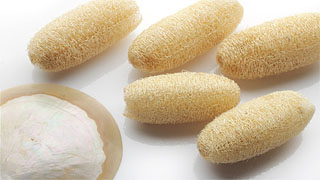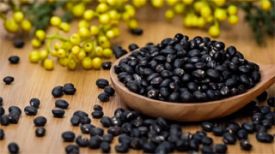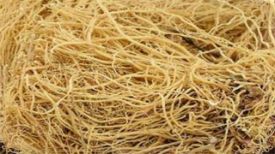
1. Alias
Shugualuo, Tianluo tendon, luffa net, luffa flesh, luffa cloth, Tianluo thread, luffa tendon, Qianlou.
2. Plant morphology
Annual climbing herb. When young, the whole plant is densely covered with soft hairs, and when old, it is almost hairless. The stem is round, often with angular edges, and the young stem is green, sparsely covered with soft hairs. Leaves alternate, petiole polygonal, with soft hairs; The leaves are circular in shape, with 3 to 7 palmar lobes. The lobes are often triangular in shape, with fine teeth on the edges. The upper part is dark green, and the lower part is light green. They have prickly hairs when young and are rough and hairless when old. Flowers are unisexual and monoecious; Female flowers solitary, peduncle; Male flowers are racemes with 5 sepals, deeply lobed, green lobes, ovate lanceolate, covered with fine soft hairs on the outside; The corolla is yellow, light yellow, with 5 deep lobes, wide ovate lobes, and wavy edges; Stamens 3-5, anthers 2-chambered, often curved like an "S" shape, filaments separated. Gouguo often droops, is cylindrical in shape, and has green longitudinal stripes; Seed ovate, black, winged at the edges. The flowering period is from May to July, and the fruiting period is from June to September.
3. Origin distribution
It is cultivated in various parts of our country. Mainly produced in Zhejiang, Jiangsu, Fujian and other places. The quality produced in Cixi, Zhejiang is the best.
4. Harvesting and processing
When the fruit matures in summer and autumn, the skin turns yellow and the interior dries up, pick it and rub off the outer skin and flesh; Or soak in water, wait for the skin and flesh to rot, remove, wash, cut off both ends, pat off the seeds, dry and flatten.
5. Characteristics of medicinal herbs
A fine and tough network of interwoven filamentous vascular bundles. The whole body is flattened in a long cylindrical or angular shape, with thin and slightly curved ends, measuring 25-70 centimeters in length and 5-10 centimeters in diameter. The surface is yellow white to dark yellow, and sometimes there are residual fruit peels and membranous flesh. The body is light, tough, elastic, and difficult to break. The transverse section shows three compartments of the ovary, hollow, and occasionally residual seeds. Qi is absent, with a mild taste.
6. Sexual Taste Returning to the Classics
Flat in nature, sweet in taste. Return to the lung meridian, stomach meridian, and liver meridian.
7. Effect and Function
Promote blood circulation, unblock meridians, and dispel wind. A blood activating painkiller classified under the category of blood activating and stasis removing drugs.
8. Clinical application
The dosage is 3-12 grams. Used to treat chest and rib pain, abdominal pain, back pain, testicular pain, menstrual pain in women, and breast milk obstruction caused by various reasons such as qi and blood stasis and blocked meridians; Cough caused by lung heat, hemorrhoids, fistulas, etc.
9. Pharmacological research
Analgesia; Anti-inflammatory; calm. Decoction, fresh juice, and methanol extract all have cough stopping effects; Methanol extract has a significant effect on increasing respiratory secretion of phenol red; Decoction and alcohol infusion have inhibitory effects on pneumococcal and common respiratory bacteria.
10. Chemical composition
Containing cellulose, xylan, mannan, galactan, lignin, etc.
11. Usage taboos
People with spleen and stomach deficiency and cold should use less loofah collaterals.
12. Compatibility prescription
① To treat chest and rib pain: 9 grams each of stir fried loofah, red peony, white peony, and Corydalis yanhusuo, 6 grams of green skin, decoct and take. (Anhui Chinese Herbal Medicine)
② Treatment for chest obstruction and heart pain: 15g of lugualuo, 3g of orange luo, 10g of danshen, and 12g of xie bai. Boil it in water. (Sichuan Journal of Traditional Chinese Medicine, 1979)
③ Treat cough, phlegm, chest and rib pain: old loofah collateral burning, fine grinding. Mix with white sugar, 2 grams each time, 2-3 times a day, and take with warm water. (Food, Traditional Chinese Medicine, and Toilet Formula)
④ Treatment for rheumatic joint pain: 15g of loofah, 24g of honeysuckle vine, 12g of Chinese wolfberry, and 15g of chicken blood vine. Boil it in water. (Shandong Herbal Medicine Handbook)
⑤ Treatment for arm pain: 10g loofah, 6g gentian, 3g qianghuo, 4.5g safflower. Boil it in water. (Selected Prescriptions for Common Diseases by the Institute of Traditional Chinese Medicine)
⊙ The content of the article is for clinical reference only. Non TCM professionals are not allowed to test drugs.


